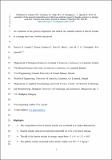| dc.contributor.author | Cusack, Patricia B. | |
| dc.contributor.author | Courtney, Ronan | |
| dc.contributor.author | Healy, Mark G. | |
| dc.contributor.author | O’ Donoghue, Lisa M.T. | |
| dc.contributor.author | Ujaczki, Éva | |
| dc.date.accessioned | 2018-10-19T08:35:16Z | |
| dc.date.issued | 2018-10-09 | |
| dc.identifier.citation | Cusack, Patricia B., Courtney, Ronan, Healy, Mark G., O’ Donoghue, Lisa M. T., & Ujaczki, Éva. (2019). An evaluation of the general composition and critical raw material content of bauxite residue in a storage area over a twelve-year period. Journal of Cleaner Production, 208, 393-401. doi: https://doi.org/10.1016/j.jclepro.2018.10.083 | en_IE |
| dc.identifier.issn | 1879-1786 | |
| dc.identifier.uri | http://hdl.handle.net/10379/14624 | |
| dc.description.abstract | Bauxite residue, the by-product produced in the alumina industry, is being produced at an estimated global rate of approximately 150 million tonnes per annum. Currently, the reuse of bauxite residue is low (∼2%), due to limitations associated with its alkalinity, salinity, low solid content, fine particle size and potential leaching of metal(loid)s. It has been identified as a potential secondary source for critical raw materials such as vanadium, gallium and scandium, which currently have an associated supply risk and high economic cost within Europe. However, there is an uncertainty regarding the possible variation in these and other physico-chemical, elemental and mineralogical parameters within bauxite residue disposal areas. This paper aimed to address this knowledge gap by examining the variation of these parameters in a bauxite residue disposal area (BRDA) over a twelve-year period. The general composition did not vary greatly within the bauxite residue examined, with the exception of pH and electrical conductivity, which ranged from 10 ± 0.1 to 12.0 ± 0.02 and from 0.4 ± 0.01 to 3.3 ± 0.2 mS cm−1, respectively. The bauxite residue contained critical raw materials, of which the amount of vanadium, gallium and scandium did not vary significantly over time. The vanadium and gallium were present in larger amounts compared to other European bauxite residues. On average the vanadium, gallium and scandium content measured in the bauxite residue samples were 510 ± 77.8, 107 ± 7.3 and 51.4 ± 5.4 mg kg−1, respectively. This shows promise for the potential reuse of bauxite residue as a secondary source for critical raw materials and also indicates that BRDAs may be potential mines for critical raw material extraction. | en_IE |
| dc.description.sponsorship | The authors would like to acknowledge the financial support of the Environmental Protection Agency (EPA) (2014-RE-MS-1). | en_IE |
| dc.format | application/pdf | en_IE |
| dc.language.iso | en | en_IE |
| dc.publisher | Elsevier | en_IE |
| dc.relation.ispartof | Journal Of Cleaner Production | en |
| dc.rights | Attribution-NonCommercial-NoDerivs 3.0 Ireland | |
| dc.rights.uri | https://creativecommons.org/licenses/by-nc-nd/3.0/ie/ | |
| dc.subject | Bauxite | en_IE |
| dc.subject | Residue | en_IE |
| dc.subject | Circular economy | en_IE |
| dc.subject | crm | en_IE |
| dc.subject | Metals | en_IE |
| dc.subject | Critical raw materials | en_IE |
| dc.title | An evaluation of the general composition and critical raw material content of bauxite residue in a storage area over a twelve-year period | en_IE |
| dc.type | Article | en_IE |
| dc.date.updated | 2018-10-19T07:25:01Z | |
| dc.identifier.doi | 10.1016/j.jclepro.2018.10.083 | |
| dc.local.publishedsource | https://doi.org/10.1016/j.jclepro.2018.10.083 | en_IE |
| dc.description.peer-reviewed | peer-reviewed | |
| dc.contributor.funder | Environmental Protection Agency | en_IE |
| dc.description.embargo | 2020-10-09 | |
| dc.internal.rssid | 14767934 | |
| dc.local.contact | Mark Healy, Room Eng-1038, Civil Engineering, Col Of Engineering & Informatics, Nui Galway. 5364 Email: mark.healy@nuigalway.ie | |
| dc.local.copyrightchecked | Yes | |
| dc.local.version | ACCEPTED | |
| nui.item.downloads | 152 | |


